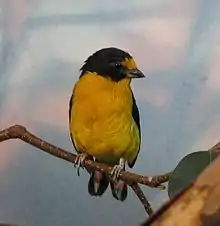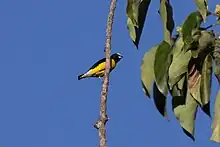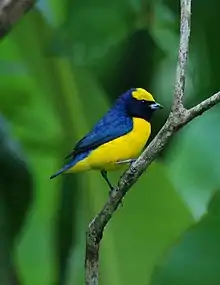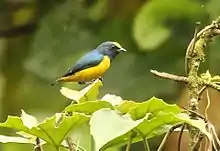Euphonia
Euphonias are members of the genus Euphonia, a group of Neotropical birds in the finch family. They and the chlorophonias comprise the subfamily Euphoniinae.
| Euphonia | |
|---|---|
 | |
| Violaceous euphonia, Euphonia violacea | |
| Scientific classification | |
| Domain: | Eukaryota |
| Kingdom: | Animalia |
| Phylum: | Chordata |
| Clade: | Dinosauria |
| Class: | Aves |
| Order: | Passeriformes |
| Family: | Fringillidae |
| Subfamily: | Euphoniinae |
| Genus: | Euphonia Desmarest, 1806 |
| Type species | |
| Euphonia olivacea[1] = Euphonia minuta Desmarest, 1806 | |
| Species | |
|
See text. | |
The genus name is of Greek origin and refers to the birds' pleasing song, meaning "sweet-voiced" (εὖ eu means "well" or "good" and φωνή phōnē means "sound", hence "of good sound").
Most male euphonias are dark metallic blue above and bright yellow below. Many have contrasting pale foreheads and white undertails. Some have light blue patches on the head and/or orangish underparts. Females much more plain, predominantly olive-green all over. They range in overall length from 9 to 11 cm (3+1⁄2 to 4+1⁄2 in). They eat small fruit and berries, particularly mistletoe (Loranthaceae). Some species may also eat some insects.[2]
Euphonias were once considered members of the tanager family, Thraupidae.[3] A molecular phylogenetic study of the finch family Fringillidae published in 2012 included 9 species from the genus Euphonia and a single species from the genus Chlorophonia, the blue-naped chlorophonia. The resulting cladogram showed the blue-naped chlorophonia nested within the Euphonia clade implying that the genus Euphonia is paraphyletic.[4] The genus was introduced in 1806 by the French zoologist Anselme Gaëtan Desmarest in his Histoire naturelle des tangaras, des manakins et des todiers with the white-vented euphonia as the type species.[5][6]
A taxonomic analysis published in 2020 found that the genus Euphonia was paraphyletic with respect to Chlorophonia. To resolve the paraphyly the authors of the study proposed the resurrection of the genus Cyanophonia that had been introduced in 1851 by Charles Lucien Bonaparte. They suggested that the Antillean euphonia (Cyanophonia musica) should be the type species. The proposed genus would contain three species: the Antillean euphonia, the golden-rumped euphonia and the elegant euphonia. An alternative and simpler way to resolve the paraphyly would be move the three species from Euphonia into Chlorophonia, which has been followed by the IOC.[7]
Species list
The genus contains 24 species:[8]
| Image | Common Name | Scientific name | Distribution |
|---|---|---|---|
 | Jamaican euphonia | Euphonia jamaica | Jamaica |
 |
Orange-crowned euphonia | Euphonia saturata | Colombia, Ecuador, and Peru |
%252C_Pte._Figueiredo%252C_Amazonas%252C_Brazil.jpg.webp) | Plumbeous euphonia | Euphonia plumbea | Brazil, Colombia, French Guiana, Guyana, Peru, Suriname, and Venezuela. |
 |
Purple-throated euphonia | Euphonia chlorotica | Argentina, Bolivia, Brazil, Colombia, Ecuador, French Guiana, Guyana, Paraguay, Peru, Suriname, Uruguay, and Venezuela. |
 |
Finsch's euphonia | Euphonia finschi | Brazil, French Guiana, Guyana, Suriname and eastern Venezuela. |
_(3)_(14412648260).jpg.webp) |
Velvet-fronted euphonia | Euphonia concinna | Colombia |
 |
Trinidad euphonia | Euphonia trinitatis | Colombia, Trinidad and Tobago, and Venezuela. |
 |
West Mexican euphonia | Euphonia godmani | Mexico |
 | Scrub euphonia | Euphonia affinis | Belize, Guatemala, Honduras and Nicaragua and along the Atlantic coastal lowlands in Costa Rica. |
 | Yellow-crowned euphonia | Euphonia luteicapilla | Costa Rica, Nicaragua, and Panama |
.JPG.webp) | White-lored euphonia | Euphonia chrysopasta | Bolivia, Brazil, Colombia, Ecuador, French Guiana, Guyana, Peru, Suriname, and Venezuela. |
%253B_Manacapuru%252C_Amazonas%252C_Brazil.jpg.webp) | White-vented euphonia | Euphonia minuta | southern Mexico south along the Pacific coast to northwestern Ecuador, the second across northern South America from the eastern Andean foothills as far east as the state of Pará in Brazil, and south to northern Bolivia. |
.jpg.webp) | Green-chinned euphonia | Euphonia chalybea | northeastern Argentina, Brazil and Paraguay. |
.jpg.webp) | Violaceous euphonia | Euphonia violacea | Trinidad, Tobago and eastern Venezuela south to Paraguay and northeastern Argentina. |
_male.jpg.webp) | Yellow-throated euphonia | Euphonia hirundinacea | from Belize south to western Panama |
_male.jpg.webp) | Thick-billed euphonia | Euphonia laniirostris | Bolivia, Brazil, Colombia, Costa Rica, Ecuador, Panama, Peru, and Venezuela. |
.jpg.webp) | Spot-crowned euphonia | Euphonia imitans | Costa Rica and Panama. |
_male.jpg.webp) |
Olive-backed euphonia | Euphonia gouldi | southern Mexico to western Panama. |
 | Fulvous-vented euphonia | Euphonia fulvicrissa | Colombia |
.jpg.webp) | Tawny-capped euphonia | Euphonia anneae | Colombia, Costa Rica, and Panama. |
.jpg.webp) |
Orange-bellied euphonia | Euphonia xanthogaster | Bolivia, Brazil, Colombia, Ecuador, Guyana, Panama, Peru, and Venezuela. |
.jpg.webp) | Bronze-green euphonia | Euphonia mesochrysa | Bolivia, Colombia, Ecuador, and Peru. |
_%253B_Manaus%252C_Amazonas%252C_Brazil.jpg.webp) | Golden-sided euphonia | Euphonia cayennensis | Brazil, French Guiana, Guyana, Suriname and eastern Venezuela. |
%252C_Manacapuru%252C_Amazonas%252C_Brazil.jpg.webp) | Rufous-bellied euphonia | Euphonia rufiventris | Bolivia, Brazil, Colombia, Ecuador, Peru, and Venezuela. |
.jpg.webp) | Chestnut-bellied euphonia | Euphonia pectoralis | Argentina, Brazil, and Paraguay. |
The black-throated euphonia ("Euphonia vittata") is now thought to be a hybrid between the chestnut-bellied euphonia and the orange-bellied euphonia.
References
- "Fringillidae". aviansystematics.org. The Trust for Avian Systematics. Retrieved 2023-07-16.
- del Hoyo, J.; Elliott, A.; Sargatal, J.; Christie, D.A.; de Juana, E. (eds.). "Handbook of the Birds of the World Alive". Lynx Edicions. Retrieved 15 July 2015.(subscription required)
- Banks, Richard C.; Cicero, Carla; Dunn, Jon L.; Kratter, Andrew W.; Rasmussen, Pamela C.; Remsen, J.V. Jr.; Rising, James D.; Stotz, Douglas F. (2003). "Forty-fourth supplement to the American Ornithologists' Union Check-List of North American Birds". The Auk. 120 (3): 923–931. doi:10.1642/0004-8038(2003)120[0923:FSTTAO]2.0.CO;2.
- Zuccon, Dario; Prŷs-Jones, Robert; Rasmussen, Pamela C.; Ericson, Per G.P. (2012). "The phylogenetic relationships and generic limits of finches (Fringillidae)" (PDF). Molecular Phylogenetics and Evolution. 62 (2): 581–596. doi:10.1016/j.ympev.2011.10.002. PMID 22023825.
- Desmarest, Anselme Gaëtan (1806). Histoire naturelle des tangaras, des manakins et des todiers (in French). Paris: Garnery. p. 35 and plate 27 (pages and plates are not numbered).
- Paynter, Raymond A. Jr, ed. (1970). Check-list of Birds of the World. Vol. 13. Cambridge, Massachusetts: Museum of Comparative Zoology. p. 340.
- Imfeld, Tyler S.; Barker, F. Keith; Brumfield, Robb T. (2020). "Mitochondrial genomes and thousands of ultraconserved elements resolve the taxonomy and historical biogeography of the Euphonia and Chlorophonia finches (Passeriformes: Fringillidae)". The Auk. 137 (3). doi:10.1093/auk/ukaa016.
- Gill, Frank; Donsker, David (eds.). "Finches, euphonias". World Bird List Version 5.2. International Ornithologists' Union. Retrieved 5 June 2015.
External links
- Euphonia videos, photos and sounds on the Internet Bird Collection